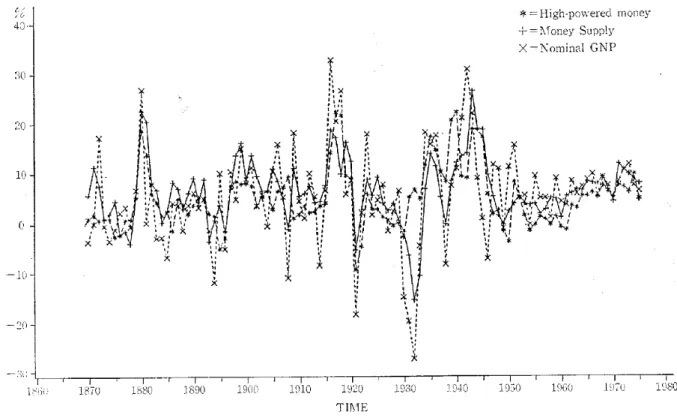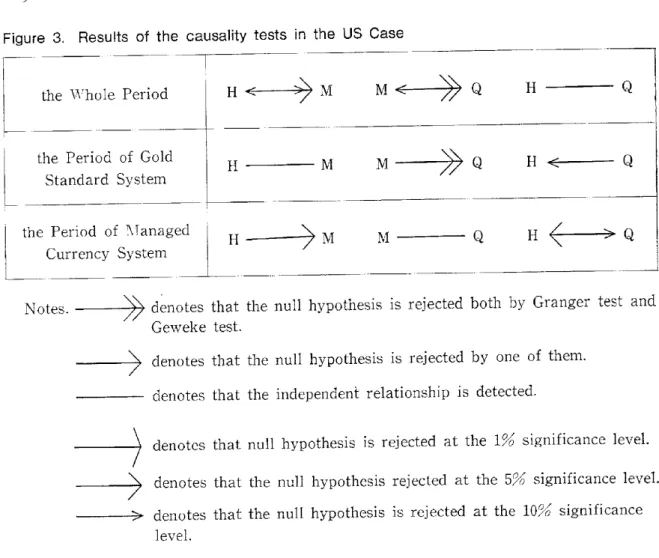<liff5E.l -- I >
Causality Tests Among High-powered Money, Money Supply and Nominal GNP : the US,
1871--1975 and the UK, 18741975`
Koji KOBAYASHI
r . Introduction
II . The relation among Granger test, Sims test and Geweke test
III . Results of causality tests in the US case 1V . Results of causality tests in the UK case V . Summary
I. Introduction
This paper reports some fact findings which are detected by the statistical methods of causality test among high-powered money, money supply and nominal GNP in the US and the UK cases.
We have recently tested the causal relationships among high-powered money, money supply, bank loan and nominal GNP by means of Granger test, Sims test and the decomposition of variance (using VAR model) in the Japanese case. In that case the causal relationship running from money supply to high-powered money was detected by using quarterly data, and it appeared to be the composition of the
causal relationship running from money supply to nominal GNP which was asserted by monetarism and that running from nominal GNP to high-powered money of which the most part consisted of cash in circulation, which showed the demand for cash by the public due to the transaction motive.
For the US and the UK some studies about the similar causality tests have been published by other scholars. For example, for the US Moore [11 ], using quarterly data since the middle of 1960s, found that "Increases in money wage rates ... will
* I am grateful to Professor Hirotaka Kato and other members of the Workshop of Mone- tary Studies of Soka University for their helpful comments and suggestions.
1) See Kobayashi [8] 1987a, [9] 1987b.
142 Vol. XVIII No. 3 thus lead directly to an increase in the quantity of bank credit demanded , and so to a corresponding increase in bank deposits and in the money stock" (p. 546). Feige and Mcgee [1 ] conducted Sims test using weekly data of total reserve and M1 transformed by Box-Jenkins filter for the seven years immediately preceding the 1968 amendments to Regulation D and the seven years immediately following the transi- tion to LRA (the lagged required reserve accounting conventions). And they found that "With respect to the causality issue, for the preamendment period , an examina- tion of columns 1 and 3 shows that we cannot reject, at the 5 percent level , both the hypothesis that money does not cause reserves and the hypothesis that reserves do not cause money ... Examination of columns 2 and 4 for the postamendment period reveals that the money supply is exogeneous with respect to total reserves and that money causes reserve" (p.547). On the other hand, Meltzer [10 ] stated , for the time period from March 1947 to March 1965, that "Evidence from past periods suggests that the monetary base is the most important determinant of the money supply and that there is a high degree of association between the base and the money stock ... In the past, 85 percent of the variance of the monthly change in money—currency and demand deposits—resulted from changes in the monetary base and changes in Treasury deposits at commercial bank in the current and previous month" (p. 18)2). Sims [13 ] detected the causal relationship running from monetary base to nominal GNP and that running from M1 to nominal GNP for the period 1949 111-1968 IV. In his paper all the variables used in regressions were prefiltered using Nerlove filter 1-1.5L+.5625L2.
For the UK Goodhart [4] analyzed the causal sequence of the equilibrating mechan- ism of gold standard with monthly data (in Chap. 14) and with weekly data (in Chap. 15). And he stated that "The inference of this finding is that movements in the money supply were adapted, and accommodated, to movements in money incomes, so that the direction of causation ran from increase in incomes to increases in money balances, not vice versa" (p. 11). Williams, Goodhart and Gowland [14 ] tried Sims test with quarterly data transformed by GLS filter for 1958 1-1971 III and they found some evidence of unidirectional causality running from nominal income to narrow money.
2) For M2 case Meltzer [10] stated "The relation between monthly changes in the monetary base and money plus time deposits is not as good. Nevertheless, more than 75 per cent of the variance of the monthly changes in this monetary aggregate can be controlled by using the base as a target and estimating Treasury deposits as accurately as in the past"
(p. 19)
December 1988 /j '' : Causality Tests Among High-powered Money143
These results as so far reviewed were all detected by using short period data such as weekly data, montly data and quaterly data.
Now we can utilize the long series of the relevant annual data for the US and the UK published in Friedman and Schwartz [2 ]'>, so that in this paper we will test the causal relationships among high-powered money, money supply and nominal GNP using those annual data for the US and the UK and examine the validity of the monetarist assertion that the causal relationships are running from high-powered money to money supply and from money supply to nominal GNP. Since the data published in Friedman and Schwartz [2] cover the period from the middle of the 19th century to recent time (1869-1975 for the US and 1871-1975 for the UK), we conduct the tests for the whole period, for the period of gold standard system (until 1933 for the US and until 1931 for the UK) and for the succeeding period, that is, the period of managed currency system.
We utilize the data as transformed into the rate of change as compared with the preceding year (See Figure 1 and 2).
The statistical methods of causality test used in this paper are only Granger test and Geweke test4 . Statistical method of Sims test is not used here. Reference should be made to some comparative studies of the various methods of causality test. Nelson and Schwert [12] found that the most powerful test was Granger test.
Geweke, Meese, and Dent [3 ] found that Granger test and Geweke test were prefered to Sims test. Guilkey and Salemi [6 ] found that both Granger test and Geweke test were more powerful than Sims test, and they recommended Granger test because this test was computationally the least expensive of the three and resulted in the fewest degrees of freedom lost from formation of lags and leads. Therefore we use only Granger test and Geweke test and don't use Sims test. And we don't use the method of decomposition of variance, either. Because the result of that method is very likely to be affected by the change of arrangement order of variables in the decomposition of variance when using annual data which has large coefficients of correlation among contemporaneous residuals5) .
The length of the lag in Granger test and Geweke test is determined by AIC 3) Friedman and Schwartz [2] 1982, Table 4.8, pp. 122-129 for the US and Table 4.9,
pp. 130-137 for the UK.
4) Geweke test is a lagged dependent variable version of Sims test introduced in Geweke et al. [3] 1983. But we call it "Geweke test" in this paper.
5) Indeed this time we conducted the method for some cases and found that the results were affected by the change of arrangement order of variables. See also Kobayashi [9]
1987b.
z44 Vol. XVIII, No. 3
Figure 1. High-powered money, Money Supply and (Annual Rate of Change)
Nominal GNP in the US
40•
30
20
10
0
-10
-



